The Tesla Cybertruck, an electric pickup that has stirred much attention for its radical design and ambitious technology, has recently made headlines again. Tesla has expanded its offerings with a significant update, allowing a select few Cybertruck owners to experience hands-free driving on U.S. highways. This development represents a critical moment not only for the Cybertruck but for Tesla as a whole, as it attempts to streamline its product offerings amidst a competitive landscape.
At the heart of the Cybertruck’s new feature is an advanced “end-to-end” driving capability powered by a neural network. According to Ashok Elluswamy, Tesla’s AI lead, this technology enables the vehicle to navigate complex highway conditions without direct input from the driver. This innovation showcases Tesla’s commitment to integrating artificial intelligence into automotive technology, aiming to set a standard in the evolving electric vehicle landscape. Musk’s enthusiastic acknowledgment of this achievement further emphasizes the importance the company places on maintaining its technological edge.
However, while some drivers may relish the thought of more automated highway driving, this feature is still in its nascent phase and currently limited to a handful of users who opted into early access. The wider rollout is still unspecified, raising questions about the speed with which Tesla can implement developments. Critics argue that the limited release of such a high-profile feature reflects Tesla’s ongoing struggle to maintain customer satisfaction against a backdrop of delayed timelines and feature rollouts.
Despite the cutting-edge nature of Tesla’s autonomous features, safety remains a significant concern. Current Tesla manuals clarify that the “Full Self-Driving” (FSD) feature, although innovative, still requires drivers to pay attention. Tesla has faced backlash in the past regarding potential customer misinterpretations of these systems, which could lead to dangerous situations. This issue is further amplified by the National Highway Traffic Safety Administration’s (NHTSA) findings that the older Autopilot feature was linked to numerous accidents, including fatal incidents.
The company has faced legal repercussions related to their Autopilot system, including class action lawsuits from customers who claimed that they were misled about the capabilities of their vehicles. These challenges put Tesla in a precarious position as it navigates both technological innovation and public perception regarding vehicular safety. The need for robust user education around these features cannot be overlooked, especially as the company pushes for their broader adoption.
Tesla’s announcement comes at a pivotal moment as multiple automakers are intensifying their ventures into electric and autonomous driving technologies. While Tesla once held a commanding lead in electric vehicle technology, competition is rapidly closing that gap. Rivals are not just leaning on electric powertrains but are also investing heavily in their self-driving capabilities. Musk has recently reiterated that Tesla’s substantial value lies in its advancements in autonomy—an assertion that aims to reassure stakeholders and customers alike amid growing competition.
In addition to their ongoing battles with the outside market, customer expectations are mounting in the face of previously promised features that remain unfulfilled. With many early Cybertruck adopters having paid a premium for features that have yet to fully materialize, there is an underlying tension between Tesla’s ambitions and consumer experience. Insights reveal that some Cybertruck users have already expressed satisfaction with the new feature; however, continued success will rely on Tesla managing the dual pressures of maintaining safety measures and delivering on their high-profile promises.
As anticipation builds for the upcoming event in Southern California on October 10, where Musk has touted plans to unveil a fully autonomous taxi service dubbed the “Cybercab,” the stakes are higher than ever for Tesla. The potential introduction of the Cybercab could define the future of Tesla’s self-driving narrative, offering clarity on whether it can deliver on its promises of full autonomy.
While the Cybertruck’s new hands-free driving capability represents a leap toward an ambitious vision of the automotive future, it also walks a fine line. As Tesla ventures deeper into the realm of automated driving, how it addresses safety, legal challenges, and customer expectations will ultimately determine its success in maintaining a leadership position in the evolving electric vehicle market.

